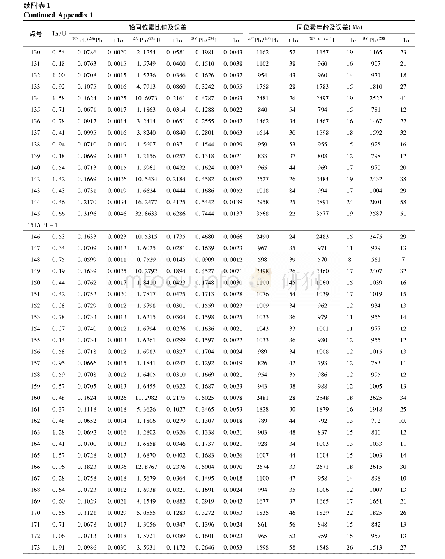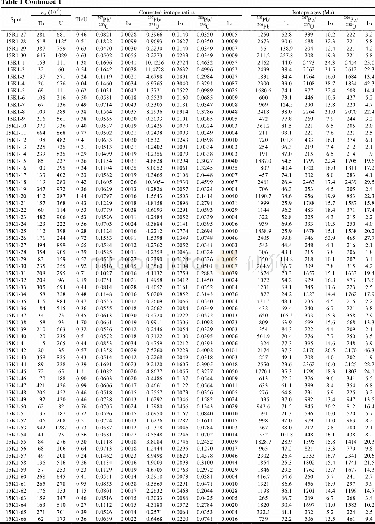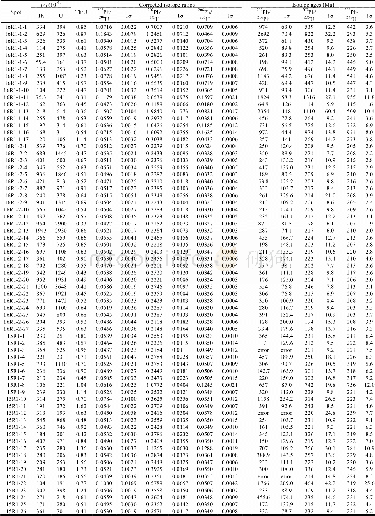《Table 1 LA–ICP–MS U–Pb isotopic data for the series I quartz diorite and the series II monzogranite
 提示:宽带有限、当前游客访问压缩模式
提示:宽带有限、当前游客访问压缩模式
本系列图表出处文件名:随高清版一同展现
《"Isotope Geochronologic and Geochemical Constraints on the Magmatic Associations of the Collisional Orogenic Zone in the West Kunlun Orogen, China"》
Series I:The cathodoluminescence(CL)images(Fig.3a)of the zircons from the quartz diorite granite sample(JJWX–04)show that these zircons are 90–180μm long,mostly euhedral to subhedral,and have clear oscillatory zones indicating a magmatic origin.A few cores show irregular dark areas,which may be caused by erosion or gas–liquid inclusions/impurities filling zircon fractures(Fig.3a;spots 11 and 12).The zircons feature relatively symmetrical dual conical surfaces(Fig.3a,spots 2,4,6,11 and 12).Zircon grains from series I have U contents of209–647 ppm(avg.437),Th contents of 142.12–724.64ppm(avg.363.56),and Th/U ratios from 0.56 to 1.12(Table 1),indicating that they are of magmatic origin as well.Fig.4a shows that the range of zircon ages is219±2.2 Ma–239±3.5 Ma,with a weighted mean age of224.0±2.0 Ma(MSWD=1.1,96.1%confidence level),which represents the crystallization age of the intrusion.
| 图表编号 | XD0017169700 严禁用于非法目的 |
|---|---|
| 绘制时间 | 2018.04.01 |
| 作者 | WANG Chan、LIU Hao、DENG Jianghong、LIU Xianfan、ZHAO Fufeng、WANG Chun、TIAN Xin |
| 绘制单位 | School of Earth Science, Chengdu University of Technology、State Key Laboratory of Oil and Gas Reservoir Geology and Exploitation, School of Energy, Chengdu University of Technology、School of Earth Science, Chengdu University of Technology、School of Earth |
| 更多格式 | 高清、无水印(增值服务) |
查看“Table 1 LA–ICP–MS U–Pb isotopic data for the series I quartz diorite and the series II monzogranite”的人还看了
-

- 表1 松岭地区早白垩世花岗岩类LA--ICP--MS锆石U--Pb定年结果LA--ICP--MS zircon U--Pb data for Early Cretaceous granites from Songling area
-

- 附表1 牛角河组变余岩屑长石石英杂砂岩碎屑锆石LA-ICP-MS U-Pb年代学测试结果Appendix 1 LA-ICP-MS U-Pb isotopic compositions of zircon from Niujiaohe For
-

- 附表1 牛角河组变余岩屑长石石英杂砂岩碎屑锆石LA-ICP-MS U-Pb年代学测试结果Appendix 1 LA-ICP-MS U-Pb isotopic compositions of zircon from Niujiaohe For
-

- Table 1 Zircon LA-ICP-MS U-Pb data of tuffie and conglomerate samples from the North Qiangtang depression, Tibet





